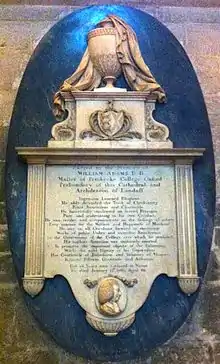William Adams (Master of Pembroke)
William Adams D.D. (1706 or '07 in Shrewsbury, England – 13 February 1789) was Fellow and Master of Pembroke College, Oxford.
William Adams | |
|---|---|
 Photograph of a copy of a portrait of William Adams, held at Abingdon School | |
| Born | 1706–1707 |
| Died | 13 February 1789 |
Early years
He was born at Shrewsbury, of a Shropshire family, and was educated at John Roysse's Free School in Abingdon (now Abingdon School)[1][2]before he was entered into Pembroke College at the age of thirteen, where he took his master's degree, 18 April 1727, and obtained a fellowship. It has generally been reported, that he was afterwards tutor to the celebrated Dr. Samuel Johnson; but Dr. Adams very handsomely contradicted this report, by saying, that had Johnson returned to College after Jordan's (his tutor's) death, he might have been his tutor: "I was his nominal tutor, but he was above my mark." A friendship, however, commenced between them, which lasted during the life of Dr. Johnson, to whose memory Dr. Adams did ample justice.
Curacy

In 1732, he was presented to the curacy, or, as usually called, the vicarage of St. Chad's in Shrewsbury, and on this occasion left the college. In 1756, he visited Oxford, and took his degrees of BD and D.D., and then went back to Shrewsbury, where he discharged the duties of his ministry with exemplary assiduity, patience, and affection; and contributed a very active part in the foundation of the Salop infirmary, and in promoting its success. The year before he went last to Oxford, he was presented to the rectory of Cound in Shropshire, by Mrs. Elizabeth Cressett of that place, and retained it during his life.
In 1775, about 43 years after he left college, John Ratcliffe, master of Pembroke college, died; and although Dr. Adams had out-lived almost all his contemporaries, the gentlemen of the college came to a determination to elect him, a mark of respect due to his public character, and highly creditable to their discernment. He accordingly became master of Pembroke, 26 July 1775,[3][2] and in consequence obtained a prebend of Gloucester, which is attached to that office. He now resigned the living of St. Chad, to the lasting regret of his hearers, as well as of the inhabitants at large, to whom he had long been endeared by his amiable character, and pious attention to the spiritual welfare of his flock. He was soon after made archdeacon of Llandaff.
Over the college he presided with universal approbation, and engaged the affections of the students by his courteous demeanour and affability, mixed with the firmness necessary for the preservation of discipline. In his apartments here, he frequently cheered the latter days of his old friend Dr. Johnson, whom he survived but a few years; dying at his prebendal house at Gloucester, 13 January 1789, aged 82. He was interred in Gloucester Cathedral, where a monument was erected, with an inscription, which celebrates his ingenuity, learning, eloquence, piety, and benevolence.
Dr. Adams married Miss Sarah Hunt, by whom he left a daughter, married, in 1788, to B. Hyatt, esq. of Painswick, in Gloucestershire, who died July 1810.
Dr. Adams's first publications were three occasional sermons, printed 1741, 1742, 1749; but his principal work was an Essay on Hume's Essay on Miracles, 8vo, 1752; which was long considered as one of the ablest answers that appeared to David Hume's writings, and was distinguished for acuteness, elegance, and urbanity of style. Hume, whom he once met in London, acknowledged that he had treated him much better than he deserved.
This work was followed by other occasional sermons, which the author collected into a volume, and published in 1777. Only one of these sermons involved him in a controversy. It was entitled "On true and false Doctrine," preached at St. Chad's 4 September 1769, and touched upon some of the principles of the Methodists, in consequence of Dr. Adams having lent his pulpit to the Rev. William Romaine, who had there preached a sermon, the tendency of which Adams thought it his duty to counteract. This produced a series of pamphlets between the friends of the respective parties; but it is somewhat singular that neither Adams nor Mr. Romaine took any part in the controversy, nor did Mr. Romaine publish the sermon which had occasioned it. The dispute turned principally on the degree of Calvinism to be found in the Articles, &c. of the Church of England.
Sources
| Wikiquote has quotations related to: William Adams |
- Chalmers, Alexander. Appendix to The General Biographical Dictionary. London, [c. 1820]
| Academic offices | ||
|---|---|---|
| Preceded by John Ratcliffe |
Master of Pembroke College, Oxford 1775–1789 |
Succeeded by William Sergrove |
References
- "Object 6: Portrait of Thomas Tesdale". Abingdon School.
- Preston, Arthur Edwin (1929). St.Nicholas Abingdon and Other Papers, pre isbn. Oxford University Press. p. 363.
- "Masters". Pembroke College, Oxford.